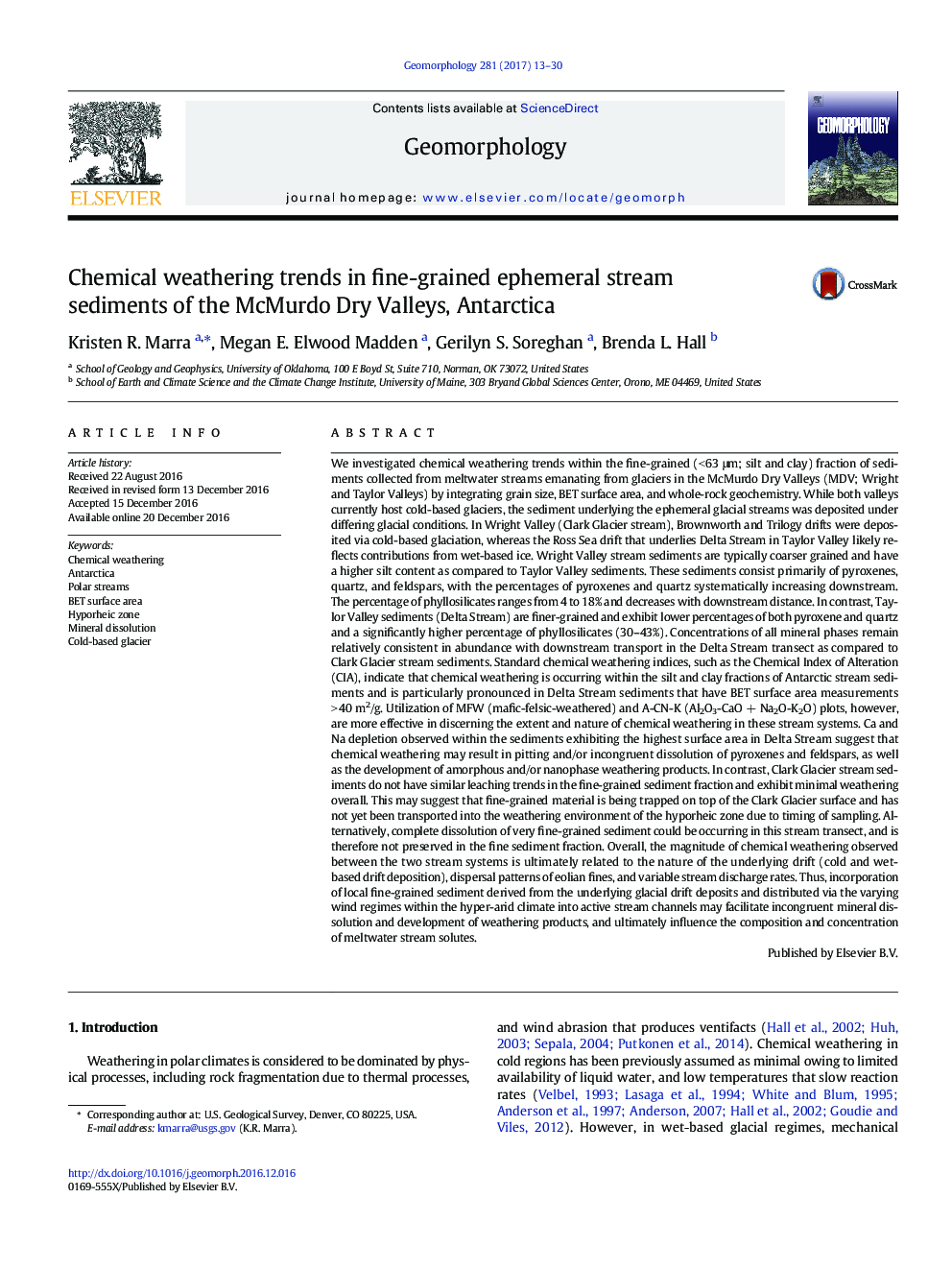| کد مقاله | کد نشریه | سال انتشار | مقاله انگلیسی | نسخه تمام متن |
|---|---|---|---|---|
| 5781015 | 1635368 | 2017 | 18 صفحه PDF | دانلود رایگان |
عنوان انگلیسی مقاله ISI
Chemical weathering trends in fine-grained ephemeral stream sediments of the McMurdo Dry Valleys, Antarctica
دانلود مقاله + سفارش ترجمه
دانلود مقاله ISI انگلیسی
رایگان برای ایرانیان
کلمات کلیدی
موضوعات مرتبط
مهندسی و علوم پایه
علوم زمین و سیارات
فرآیندهای سطح زمین
پیش نمایش صفحه اول مقاله

چکیده انگلیسی
We investigated chemical weathering trends within the fine-grained (< 63 μm; silt and clay) fraction of sediments collected from meltwater streams emanating from glaciers in the McMurdo Dry Valleys (MDV; Wright and Taylor Valleys) by integrating grain size, BET surface area, and whole-rock geochemistry. While both valleys currently host cold-based glaciers, the sediment underlying the ephemeral glacial streams was deposited under differing glacial conditions. In Wright Valley (Clark Glacier stream), Brownworth and Trilogy drifts were deposited via cold-based glaciation, whereas the Ross Sea drift that underlies Delta Stream in Taylor Valley likely reflects contributions from wet-based ice. Wright Valley stream sediments are typically coarser grained and have a higher silt content as compared to Taylor Valley sediments. These sediments consist primarily of pyroxenes, quartz, and feldspars, with the percentages of pyroxenes and quartz systematically increasing downstream. The percentage of phyllosilicates ranges from 4 to 18% and decreases with downstream distance. In contrast, Taylor Valley sediments (Delta Stream) are finer-grained and exhibit lower percentages of both pyroxene and quartz and a significantly higher percentage of phyllosilicates (30-43%). Concentrations of all mineral phases remain relatively consistent in abundance with downstream transport in the Delta Stream transect as compared to Clark Glacier stream sediments. Standard chemical weathering indices, such as the Chemical Index of Alteration (CIA), indicate that chemical weathering is occurring within the silt and clay fractions of Antarctic stream sediments and is particularly pronounced in Delta Stream sediments that have BET surface area measurements > 40 m2/g. Utilization of MFW (mafic-felsic-weathered) and A-CN-K (Al2O3-CaO + Na2O-K2O) plots, however, are more effective in discerning the extent and nature of chemical weathering in these stream systems. Ca and Na depletion observed within the sediments exhibiting the highest surface area in Delta Stream suggest that chemical weathering may result in pitting and/or incongruent dissolution of pyroxenes and feldspars, as well as the development of amorphous and/or nanophase weathering products. In contrast, Clark Glacier stream sediments do not have similar leaching trends in the fine-grained sediment fraction and exhibit minimal weathering overall. This may suggest that fine-grained material is being trapped on top of the Clark Glacier surface and has not yet been transported into the weathering environment of the hyporheic zone due to timing of sampling. Alternatively, complete dissolution of very fine-grained sediment could be occurring in this stream transect, and is therefore not preserved in the fine sediment fraction. Overall, the magnitude of chemical weathering observed between the two stream systems is ultimately related to the nature of the underlying drift (cold and wet-based drift deposition), dispersal patterns of eolian fines, and variable stream discharge rates. Thus, incorporation of local fine-grained sediment derived from the underlying glacial drift deposits and distributed via the varying wind regimes within the hyper-arid climate into active stream channels may facilitate incongruent mineral dissolution and development of weathering products, and ultimately influence the composition and concentration of meltwater stream solutes.
ناشر
Database: Elsevier - ScienceDirect (ساینس دایرکت)
Journal: Geomorphology - Volume 281, 15 March 2017, Pages 13-30
Journal: Geomorphology - Volume 281, 15 March 2017, Pages 13-30
نویسندگان
Kristen R. Marra, Megan E. Elwood Madden, Gerilyn S. Soreghan, Brenda L. Hall,